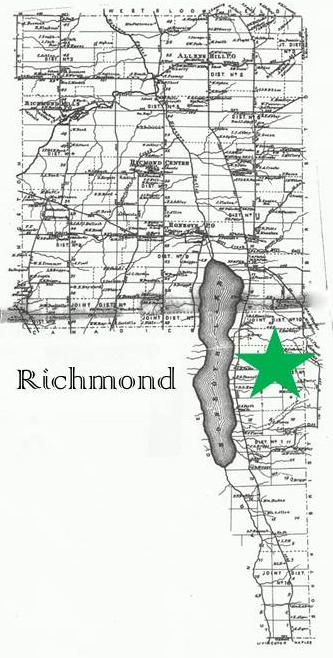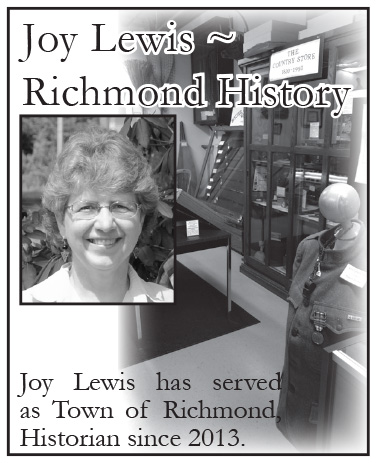Richmond History – Stepping Stones to Success
– By Joy Lewis
Hugh Hamilton (October 31, 1770-March 1, 1851)
A January thaw is not an unusual occurrence in Finger Lakes Country. Yet the particular incidence of thaw in the winter of 1811 became an obstacle to be met with perseverance – a trait much in evidence in the character of one of Richmond’s pluckiest forefathers.
Eight months earlier, in May of 1810, forty-year-old Hugh Hamilton had set out on horseback from his home in Blandford, Massachusetts, intent on discovering a new home place for himself and his family. Making his way westward as far as Erie, Pennsylvania, and not being satisfied with the lands along the shores of Lakes Ontario and Erie, he turned back to the east. He had in his mind the hills and valleys he’d earlier traversed through Ontario County. At Honeoye Lake he found just the property he was looking for.
He bought a hundred-acre parcel near the foot of the lake on the east side. It took him the better part of a month to put up a small log house. And the while, he looked about for an opportunity of making a living. He found it when Mr. David Crooks offered to sell him half-interest in a nearby grist mill.
The mill, on the south side of Mill Creek where the east branch crosses (present-day) East Lake Road, was just a bit north of Hugh’s property. Less than a decade old, the mill had been built in 1802 by Oliver Phelps, Jr. For years it was known locally as the “Phelps mill” even after it became the property of David Crooks and – in 1810 – Hugh Hamilton.
For the remainder of the year Hugh stayed in Richmond and operated the mill. In December he went back to Massachusetts where he packed up the family and all their worldly goods. Hugh and his wife Isabel Knox had six children: Justin was fifteen; Polly, twelve; and Charlotte, ten; the younger children were William, who was seven; Lucinda, five; and David, two. They said good-bye to their native country in early January. Traveling by sleigh, the trip was easy going for a good deal of the way, as there was a heavy snowpack to smooth them along. But by the time they reached Cayuga Lake the thaw had set in. The final sixty miles was an arduous slog through mud and slush.
At last they reached their destination in Richmond. In his first half-decade on his new homestead Hugh cleared the woods from the road to the lake, planted a few meager crops, and continued to operate the mill. His son William in later years wrote of his father’s work: “While father ran the old mill on the creek, all the south and east part of Richmond and West Bristol depended upon it for their grinding. It had but one small run of burrs, and when there was sufficient water, ran constantly. During the dry season it ran but little… Surplus grain was then sent to Albany to market, by wagon or sleigh.”
In 1815 Hugh sold his interest in the mill back to Mr. Crooks, with the idea of concentrating on his farm. The next few years would be difficult ones for the Hamilton family. The year of 1816 – known in upstate New York as “The Year Without a Summer” when every month saw a frost – caused hardship to all the settlers along Honeoye Lake. Hugh and his neighbors were unable to harvest a crop. Then a crippling blow struck when he was notified in a legal proceeding that the title to his hundred acres was in dispute: he’d bought it from a man who’d had no right to sell it. The Hamiltons must begin again.

A great number of the settlers along the lakeshore decided they too must start over. Many of them entered into an arrangement with Mr. Gideon Granger of Canandaigua. Sight unseen they traded their Richmond property for land in Hardin County, Kentucky. Among the many who set out for Ken-tuck in the summer of 1818 was Hugh’s eldest son Justin, now a young man nearing twenty.
Hugh, however, was minded to stay at Honeoye Lake. A mile or so south of where he’d started, he found an appealing property. With help from his son William, he set in to clear the land. It would be years, he knew, before the farm would begin to pay. It was about this time that he arranged to buy John Green’s distillery. For the past decade Green had operated his whiskey works along the creek back of the Hamilton homestead (Briggs Gully), but now he was off to Kentucky.
The Hamilton family’s troubles, however, were not over with their move. Nineteen-year-old Charlotte died in their third year at the new place, and Polly a few years later. William married and took his bride to settle in Ohio. Hugh’s daughter Lucinda married Abraham Pennell and went with him to his nearby farm. This property, north of the Hamiltons’ farm, had been the place where Hugh had first settled his family.
Both Hugh and Isabel were nearing sixty, and both were in need of “looking after.” It was their youngest, David, just now coming of age, who elected to stay on the home farm and continue to build upon the foundation laid by his father. David married Laura Belle Moore at the end of November 1831 and brought his bride home to Honeoye Lake. Nine children arrived in quick succession, though not all lived to reach adulthood. Four of Hugh’s grandchildren joined his deceased daughters in the family burial ground.
Forty years after his arrival, and only five months after his wife’s death, Hugh Hamilton died. His son David carried on the work of making the farm a success. His family “was large, and both firmness of heart and steadiness of resolution were required to enable them to surmount the ills of poverty. All learned the priceless quality of frugality, and the sweat of honest, toilsome labor was no stranger to their faces.” As a result of his never-ceasing industry, David “grew in wealth, not rapidly, but by years of persevering industry” until he owned a prosperous farm of 675 acres. (History of Ontario County)
